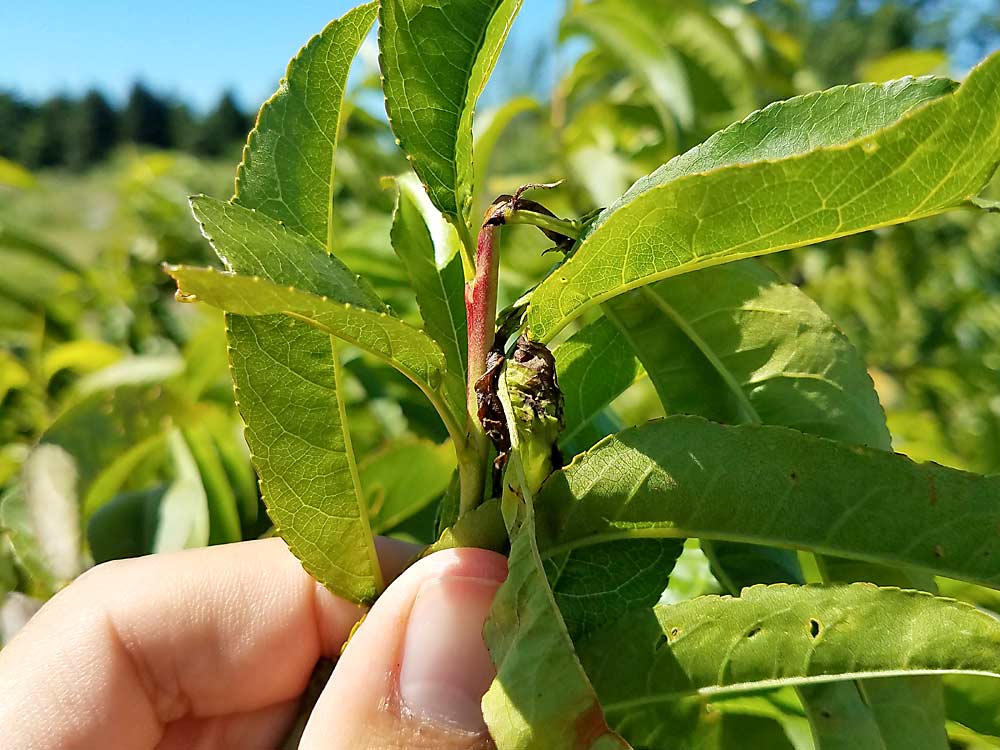
Despite low capture numbers for oriental fruit moths in pheromone-baited field lures, some Michigan growers have been finding considerable OFM activity, such as this shoot damage in a Michigan orchard in 2017. (Courtesy David Jones/Michigan State University Extension)
Oriental fruit moths (OFMs) are frustrating many a Michigan peach grower, primarily because the actual number of moths in the orchard can be far higher than the traps indicate. A new study helps explain what’s going on and what growers can do about it.
Mystery solved
The disparity between trap captures and OFM population size became evident in 2017. At that time, many Michigan growers were just returning to using pheromone-based mating disruption, after taking a
hiatus from the practice for several years.
To monitor OFM, they used the same pheromone-baited traps they had relied on prior to mating disruption, and that presented a problem, according to Michigan State University Extension fruit tree educator David Jones.
He spoke about his recent study on trap efficacy at the Great Lakes Fruit, Vegetable and Farm Market Expo in Grand Rapids, Michigan, in December.
The issue is that standard pheromone lure-baited traps cannot always compete with the pheromone presence created by the application of a commercial mating disruption product, he said. As a result, many traps in 2017 captured few, if any, moths, so growers couldn’t determine the start of moth activity (biofix) to mount effective control measures.
New lures that aim to solve this problem, by combining standard mating pheromones with other attractants, have shown promise in trials in Pennsylvania and North Carolina, so Jones wanted to assess the impact of trap type and placement in Michigan peach orchards.
Lure them in
In 2017, MSU researchers started by setting pheromone-baited traps at three woodland-adjacent orchards in West Central Michigan during the period from the second to third generation of moths. They placed traps in three locations: in the woods at least 20 meters away from the peach orchard, well within the orchard, and at the orchard’s edge.
The traps placed in the woods picked up both second- and third-generation moth flights, he said, but those installed within or at the edge of the orchard did not. This suggested “right off the bat” that mating disruption was affecting the performance of the pheromone traps placed in the orchard interior, Jones said.
This is an important note to make, he said, because that’s where most crop scouts and farmers tend to place their traps. Data from 2017 indicated the interior was actually the least effective location for a
pheromone-baited lure in a disrupted peach orchard and that exploring an alternative method and trap type was necessary.
In 2018, they expanded the study to include more orchards in southwestern Michigan and West Central Michigan, extended it to cover all three generations of OFM, and added a second brand of pheromone lure and a new Trécé combo lure, released in 2017.
The Trécé combo lure employs a plant volatile, or feeding cue, to entice OFM, rather than a mating cue, so that it performs better than traditional pheromone-baited lures in the presence of mating disruption.
The combo lure was a clear winner in the trap catch number as well as trap catch consistency from week to week, over the course of the study.
Catch numbers for the combo lure provided “really nice peaks for all three generations during the growing season, and with clear initiation and onset, clear climb, clear decline, and a nice break in between,” Jones said. “The only spots where we got any kind of catch off of the pheromone lures was when they were put in the woods. We essentially got blanked on the edge (of the orchard) and in the block.”
Another contributing factor to the trap efficacy issue is that growers with a high wild population of OFM can experience edge damage from reproduction that happens outside of their orchards and may not be reflected in traps placed in the orchard interior.
Mated females from adjacent woodlands are not deterred by mating disruption, nor are they attracted to pheromone-baited lures. As a result, mated wild females can cause heavy damage, particularly at the edges of peach orchards near woodlands.
What now?
Jones is excited about the combo lure and research currently underway to determine how its catch numbers relate to the established thresholds currently available for pheromone lures.
“Given that this combo lure is so sensitive, using the established thresholds for standard pheromone-baited lures would probably result in some overspray,” he said. “One of the immediate benefits for the combo lure is that you can actually see the generations going, (and) I do think there’s some utility for local scouting companies who are trying to follow the season-long generational flux of this pest.”
That said, pheromone lures can still be beneficial, Jones said, but growers should be careful when using mating disruption, especially if they have a strong local population.
“Placing at least one trap 20 meters outside the orchard in the wood line is the best way to use these traps and get the most efficacy, but you will still likely see some issues with consistency in your catch data,” he said.
Jones’ OFM-monitoring project was funded by the Michigan Tree Fruit Commission. •
—by Leslie Mertz
Related: Lures lead to better moth management






Leave A Comment